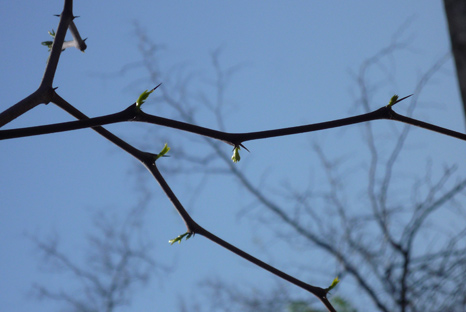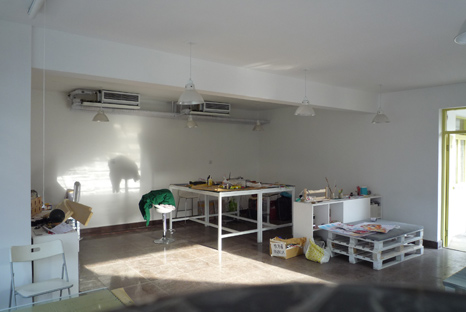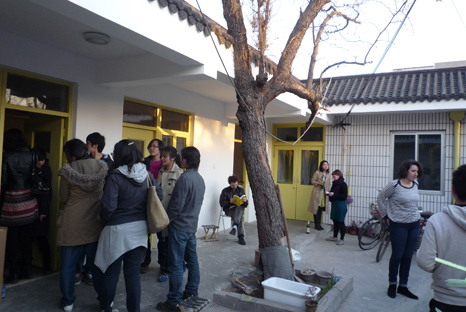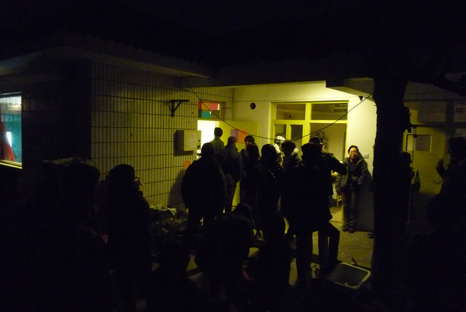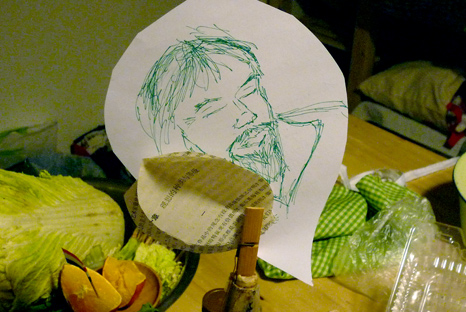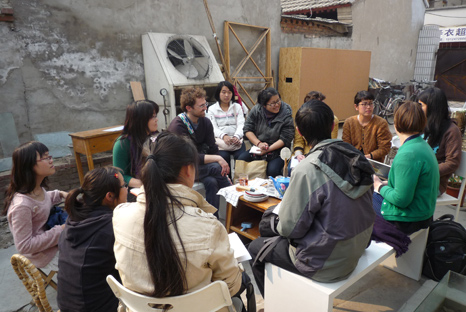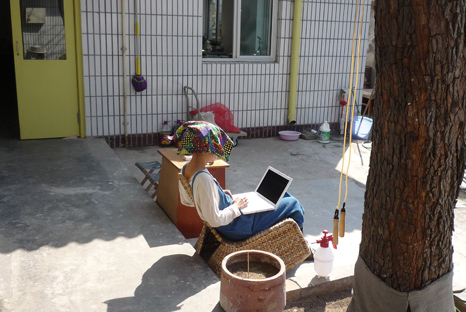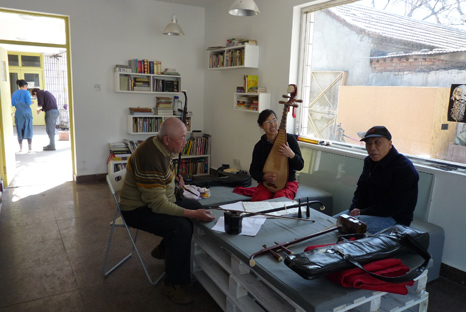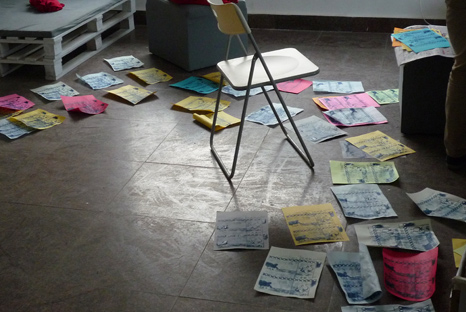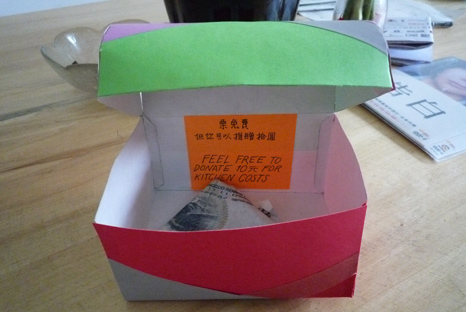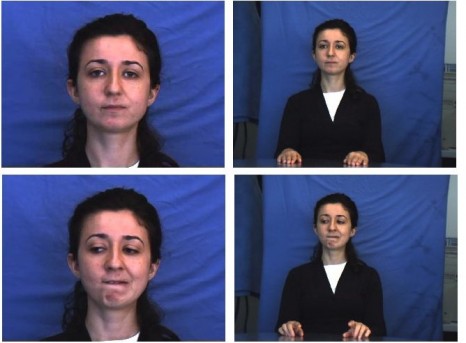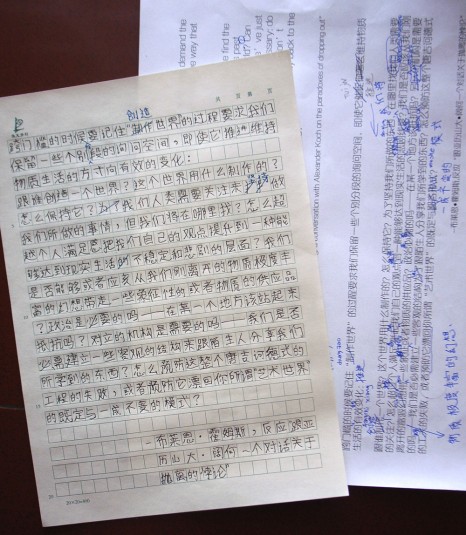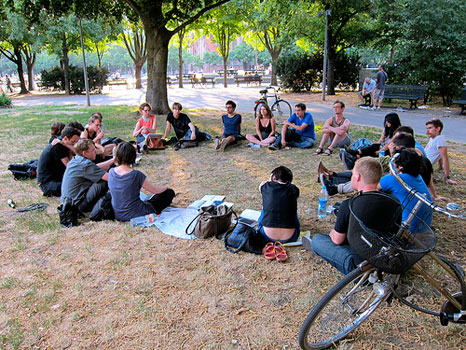Date: Tue, 27 Nov 2007 20:42:16 -0800
From: Brian Holmes
Subject: Re: <nettime> Lin Yilin
To: nettime-l@kein.org
Message-ID: <474CF1A8.5090401@wanadoo.fr>
Content-Type: text/plain; charset=ISO-8859-1; format=flowed
It’s excellent to read more about Lin Yilin, whose Documenta piece, “Safely Maneuvering Across Lin He Road” (1995) was a great discovery for me, one of the best pieces in the show. I’m just returning from Southern China, and I visited the Vitamin Creative Space in Guangzhou where Lin recently did an exhibition, more or less hidden away amidst a vegetable market in an outlying district not far from the “Love-In Mall” (just another typical shopping center overflowing with consumerism). I’m extremely curious about the Chinese art scene and I don’t quite know what to make of it. David Garcia’s remarks are a good starting point:
> What is not much commented on however is the way that
> the ‘vector’ of the visual arts has functioned in ways that
> seem to short circuit some of the restrictions on
> expression in the general Chinese media. Once again we
> see how the fragile claims to political relevance of
> contemporary art is based on the way that it is able to
> articulate certain conceptions of human freedom. In the
> case of Chinese art these freedoms have been able to arise
> in the context of small locally embedded audiences
> without the benefit of accompanying institutional > structures, galleries, critics, journals, curators, museums.
Those who went to Thermocline of Art: New Asian Waves at the ZKM a few months ago could see an amazing example of this short-circuiting by an artist named Liu Wei, who braved the absolute prohibition of contemporary Chinese society by going out to the campus of Beijing University on j-u-n-e f-o-u-r, t-w-o t-h-o-u-s-a-n-d a-n-d f-i-v-e — the 16th anniversary of the T-A-M S-q-u-a-r-e m-a-s-s-a-c-r-e — and asking people, “What day is it today?” What the video shows over and over, with only one real exception, is people breaking off, falling silent, dodging away, usually with a panic look in their eyes as the process of self-censorship kicks in, plus a confused embarrassment at having it filmed. To get how impressive this is, you have to realize that one of the most famous images in the world, the one of a man stopping a column of tanks on their way to Tiananmen square, is largely unknown in mainland China and of course, strictly censored from the Internet. Upon seeing this video I assumed that the author of “A Day to Remember” was living in exile, but no, he lives and works in Beijing (even if, not surprisingly, the piece does not show up among the videos listed on his website, www.lwstudio.com). It is as though critical art, which for almost twenty years could only exist in Western exile, were finally returning to China. In my travels and research I have come across a rather short list of currently active artists, mostly from the 1990s, who powerfully and corrosively explore the kind of limited freedom that Lin Yinlin talks about in David’s interview. The work that interests me corresponds very much to the description that Lin gives of contemporary Chinese art in general, and of the Big Tail Elephant group in particular: “It appeared as a nondescript monster which, like present day cities in China, abruptly came into existence. Driven by the insane and irrational consumerism and hedonism permeating China’s cities, people have been continuously in a state of unaccountable enjoyment, utter ignorance of the future and an excitement aroused by fierce competition. Within such a scenario, the Big Tail Elephant’s art, covering urban issues such as urban development, consumerism, traffic, population and sex culture, is inevitably imprinted with marks of the times.” The video of the artist maneuvering across Lin He Road, sheltering from the traffic behind a temporary wall of breeze blocks which he displaces brick by brick to make the crossing, takes on an incredibly vivid and paradoxical meaning when you see the tremendous sprawl of the new cities, choked with traffic and polluted, bordering on insanity but at the same time gleaming with luxury. The work could be a metaphor of an entire society moving decisively ahead under the cover of the very force of over-development that is about to become life-threatening, but at the same time, that is still the only game in town, the one you’ve got to play to be part of anything. There is a kind of wild and violent lucidity to the best of contemporary Chinese art, that asks for a response, for a dialogue, for a pragmatically critical engagement with the present.
That’s not all that’s going on, however, and if interesting art was definitely able to arise during the 90s in locally embedded situations without all the usual art paraphernalia, those days are gone today. What you see now is an explosion of art, everywhere in the Chinese cities, far beyond the biennials and the attention of the Western curators. In Beijing and Shanghai, a new museum is being built everywhere you look, there are more galleries than artists, and amidst the hustle and bustle of sales it is extremely difficult to get at the meaning of anything. Everyone will tell you that there is no difference between artists and businessmen in China: Ai Wei Wei, famous for his bicycle installations and for bringing a thousand Chinese visitors to the Documenta, is basically operating as a land developer on the outskirts of Beijing, and he is no exception, art and real estate are very closely linked, while the buzzword of “creative industries” becomes omnipresent in the coastal cities. The fate of Beijing’s Factory 798 / Dashanzi Art District is emblematic: after less than five years of tremendously interesting “locally embedded” activity, it has escaped being razed for new apartment complexes only to become a tourist attraction and luxury consumption environment under the watchful eye of the state, which is trying to figure out how to tolerate some contemporary art and prove to the rest of the world that Olympic China is no longer a land that exiles its dissidents. At the same time, it’s obviously a highly authoritarian state that censors the Internet very severely and clamps down immediately on any kind of protest, except the ones that somebody decides should be tolerated for reasons that can change tomorrow or in the next five minutes. So the degree of schizophrenia is impressive, and the apparent lack of any overt critical or even searching discussion in public is rather depressive — even if we are also getting used to that here in the USA…
As Lin himself says:
> the rapidly popular art market also brings the trial to the
> artists. Chinese contemporary artists take the risk to
> change the isolated status suddenly to become brand
> name stars. If Chinese contemporary art cannot develop a
> particular theory, then ultimately they would only be
> expensive craftwork for this period of history.
The kind of theory that Lin is talking about will be written in Chinese, to address the complexities of a national/imperial situation involving 1.3 billion people. Nobody but the Chinese artists and intellectuals can do that, and I suspect that as the construction and consumption boom tops out, enough people will become disgusted with the prevailing euphoria and greed to start forming the kinds of marginal circles and semi-secret languages that are needed. However, what gets translated on the transnational level still matters, particularly in an age when communication across borders has become so much more fluid. The blockbuster concept shows and facile biennials fit perfectly into the ambient meaninglessness. Careful work with specific artists, filmmakers and intellectuals who are given enough time and space to develop their perceptions and ideas can probably make a real contribution, both to a wider understanding of China’s situation in the world, and to the more intense and detailed debates unfolding within the country. Thanks to David and the people at Visual Foreign Correspondent for this material from Lin Yinlin, shackled to himself amidst the overwhelming cacophony of urban China.
best, Brian
[apologies to Brian and all, oh the irony, but this text has been encoded a bit here because i don’t want our website to get X’d in China… we’re in Beijing, too… a response to this mail is posted here.]
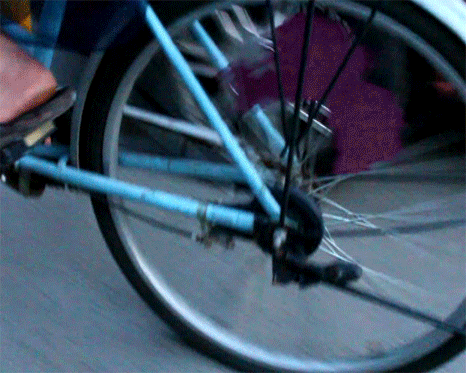

 时间 posted on: 15 May 2011 |
时间 posted on: 15 May 2011 |  发布者 author:
发布者 author: 
 分类 filed under:
分类 filed under: 